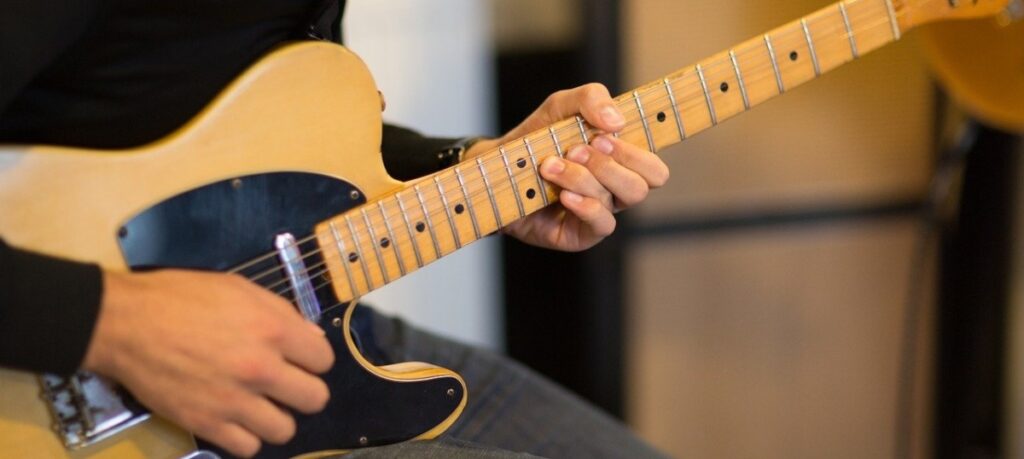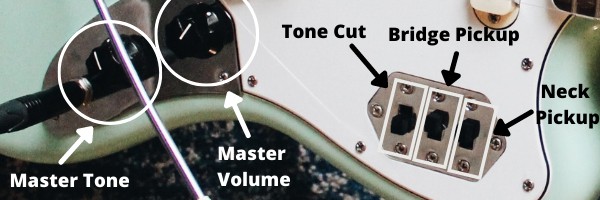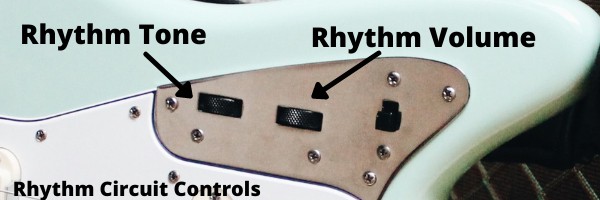If you’re in the market for a new electric guitar then the Telecaster and Jaguar from Fender and Squier are both great options to consider, but which is the best for you? In this article, I’ll compare the Jaguar and Telecaster in terms of their tone, features, look, feel and price so you can decide which to go for.
The Quick Answer
The Telecaster sounds brighter and is more straightforward to use than the Jaguar which features more complex controls. The Jaguar has a shorter scale length and an offset double cutaway body design whilst the Telecaster which has a single cutaway body. The Jaguar also has a tremolo unlike the Tele.

Comparing Features
Let’s start off by taking a look at the specifications of both models. There are several different variants in the Squier and Fender ranges so I’ve chosen to compare the following similarly priced models:
- Fender American Original ’60s
- Squier Classic Vibe
Fender Telecaster vs Jaguar
| Feature | Fender Jaguar | Fender Telecaster |
| Body Shape | Double Cutaway | Single Cutaway |
| Body Wood | Alder | Ash |
| Pickups | Two Single-Coils | Two Single-Coils |
| Neck Shape | ’60s C | U-Shape |
| Neck Wood | Maple | Maple |
| Frets | 21 | 21 |
| Fretboard Wood | Rosewood | Maple |
| Scale Length | 24” | 25.5” |
| Bridge | Tremolo | Fixed (no tremolo) |
| Tone-Cut Switch | Yes | No |
| Rhythm/Lead Circuit | Yes | No |
| Pickup Selector | 3-way | 3-way |
| Weight | 8.5 pounds (3.9 kg) | 7.5 pounds (3.4 kg) |
Squier Telecaster vs Jaguar
| Feature | Squier Jaguar | Squier Telecaster |
| Body Shape | Double Cutaway | Single Cutaway |
| Body Wood | Poplar | Pine |
| Pickups | Two Single-Coils | Two Single-Coils |
| Neck Shape | C-shape | Slim C-shape |
| Neck Wood | Maple | Maple |
| Frets | 22 | 22 |
| Fretboard Wood | Indian Laurel | Maple |
| Scale Length | 24” | 25.5” |
| Bridge | Tremolo | Fixed (no tremolo) |
| Tone-Cut Switch | Yes | No |
| Rhythm/Lead Switch | Yes | No |
| Pickup Selector | 3-way | 3-way |
| Weight | 8.5 pounds (3.9 kg) | 8 pounds (3.6 kg) |
Tone Comparison
Telecasters are well known for their versatile tones with the neck pickup offering a warmer sound which works very well for cleans and a bright and punchy bridge pickup which makes it great for a variety of music styles. The Jaguar has a complex switching configuration and sounds a bit more mellow in comparison to the Telecaster but is capable of achieving a very wide variety of tones.
Both guitars usually feature single coil pickups which are bright but thin sounding and can suffer from feedback when using high gain. This is typically why you’re rarely see either of them being used for heavy rock and metal.
Key Differences:
- The Jaguar has a shorter scale length which causes it to have a warmer and mellower tone than the Telecaster.
- Both guitars can achieve a variety of tones. The Telecaster does this by having contrasting bridge and neck tones and the Jaguar does this by using more complex switches and controls.
- The Jaguar has a tremolo bridge allowing you to create a vibrato effect. The Tele does not have this feature and instead has a fixed bridge.
Key Similarities:
- Both guitars usually have an alder or ash body and maple neck.
- Both guitars usually use single coil pickups.
Music Styles
The Jaguar was originally introduced in the ’60s but became most popular in the ’90s when used by Kurt Cobain. It’s capable of playing a variety of music styles from funk to grunge. The Telecaster has been used by a variety of famous players and is mostly known for country and rock ‘n’ roll.
Check out this video to hear the guitars played back to back.
Look and Feel
The most significant differences between the Jaguar and Telecaster mainly affect the look and feel of the instruments.
The Telecaster has a single cutaway whilst the Jaguar has a double cutaway offset body. This means that the Jaguar tends to tilt upwards more at the headstock when playing stood up and also that it’s easier to reach the upper frets.
Want to learn more about offset guitars? Check out my article discussing the pros and cons of offset body electric guitars.
The neck shape varies between models but generally the Jaguar tends to have a slimmer neck design compared to the Telecaster, particularly when comparing the original models.

The difference in scale length also affects playability. The Jaguar has a shorter 24″ scale length compared to the Telecaster’s 25.5″ scale. The shorter scale length on the Jaguar reduces the string tension making it a bit easier to bend strings.
Here’s a summary of the key similarities and differences between these guitars.
Differences:
- Scale length
- Neck shape
- Body shape
- Bridge design
- Switch/ control locations
- Weight (Jaguar is heavier due to its larger body than the Tele)
- Pickup designs
Similarities:
- Fret number (on most models)
- Tone woods
- 6 in-line headstock configuration
- Bolt-on neck construction
Comparing the Ranges
I also wanted to take a look at the different options in the Squier and Fender ranges so you can identify the models in your price range to compare. I’ve made two tables (one for Squier guitars and the other for Fender) and have used the Guitar Center prices which are correct as of the time of writing but may be subject to change. The tables are ordered from the lowest to highest price.
Squier Models
| Guitar | Origin | Pickups | Neck Shape | Price |
| Squier Bullet Telecaster | Indonesia | Single Coil | C-shape | $190 |
| Squier Affinity Telecaster | China | Single Coil/ Humbucker | Modern C | $230 |
| Squier Contemporary Telecaster | China | Humbucker | C-shape | $400 |
| Squier Classic Vibe ‘50s Telecaster | Indonesia | Single Coil | C-shape | $450 |
| Squier Classic Vibe ‘60s Telecaster | Indonesia | Single Coil | Slim C | $480 |
| Squier Classic Vibe Telecaster | Indonesia | Humbucker/Single Coil | C-shape | $480 |
| Squier Classic Vibe 70’s Jaguar | Indonesia | Single Coil | C-shape | $480 |
| Squier Contemporary Jaguar | China | Humbucker | C-shape | $480 |
Fender Models
| Guitar | Origin | Pickups | Body Wood | Neck Shape | Price |
| Fender Player Telecaster | Mexico | Single Coil/ Humbucker | Alder | Modern C | $800 |
| Fender Player Jaguar | Mexico | S-H | Alder | Modern C | $830 |
| Fender Deluxe Telecaster | Mexico | Single Coil/ Humbucker | Alder | Modern C | $950 |
| Fender Vintera Telecaster | Mexico | Single Coil/ Humbucker | Alder | ‘50s U-Shape | $950 |
| Fender Player Plus Telecaster | Mexico | Single Coil | Alder | C-Shape | $1000 |
| Fender Vintera ‘60s Jaguar | Mexico | Single Coil/ | Alder | ‘60s C | $1150 |
| Fender Road Worn ‘50s Telecaster | Mexico | Single Coil/ Humbucker | Alder | U-Shape | $1150 |
| Fender Vintera ‘60s Jaguar Modified | Mexico | Humbucker | Alder | Modern C | $1280 |
| Fender American Performer Telecaster | America | Single Coil/ Humbucker | Alder | Modern C | $1300 |
| Fender Kurt Cobain Jaguar NOS | America | Humbucker | Alder | Modern C | $1400 |
| Fender American Professional II Telecaster | America | Single Coil/ Humbucker | Alder/ Ash | Deep C | $1450 |
| Fender American Showcase Telecaster | America | Single Coil | Alder | Custom Compound | $1750 |
| Fender American Ultra Telecaster | America | Single Coil | Alder/ Ash | D-Shape | $2000 |
| Fender American Original Telecaster | America | Single Coil/ Humbucker | Alder | C-Shape | $2000 |
| Fender American Original ‘60s Jaguar | America | Single Coil | Alder | ‘60s C | $2150 |
| Fender American Ultra Luxe Telecaster | America | Single Coil/ Humbucker | Ash | D-Shape | $2400 |

Check out my complete comparison between the Stratocaster and Telecaster
Specific Design Comparisons
Now let’s take a look at the different parts of the guitars and analyse how this affects both the tone and playability of the instruments.
Pickups
Both the Jaguar and Telecaster traditionally use two single coil pickups. However, you can find humbucker variants of both models which will sound more mellow and fuller in comparison.
Typically, the Tele has a covered single coil neck pickup and a metal cased single coil in the bridge position which is angled and located on the bridge casing contributing to its bright and punchy tone. On Jaguars, both pickups are located on the body of the guitar (as opposed to on the bridge) and are both parallel (rather than angled).
Controls
The controls and switches used on these two guitars creates a very different experience and variety of tones.
The Tele keeps it very simple with a 3-way pickup selector allowing you to activate either the bridge or neck pickup alone, or both together, and it also has a single tone and single volume control which can be used to adjust both pickups.
The Jaguar’s controls on the other hand are much more complex, and to further confuse things, they are different on each model within the Squier and Fender ranges. The most traditional Jaguar models have a “lead/ rhythm switch” which activates one of two circuits.
The rhythm switch activates only the neck pickup and disengages the controls on the lower horn, so you use the volume and tone controls on the upper horn instead to adjust it. The lead switch activates the controls on the lower horn which include an on/off switch for each pickup, a master tone control, master volume control and a “tone cut” switch which cuts the mid-range.
I’d recommend checking out my guide to using a Jaguar’s controls if you’re interested in purchasing one. It takes you through each model and how to use it, with diagrams to make everything much easier to understand!


Body
The Telecaster and Jaguar typically use alder or ash bodies but the shape is very different. The Tele has a single cutaway and slab style body which doesn’t really have much edge bevelling and doesn’t have any contours. The Jaguar has a double cutaway, contoured and bevelled body shape, but it’s much larger than the Tele and has an offset shape.
The offset shape shifts the centre of balance to make the headstock tilt upwards more when playing stood up. It’s all personal preference but many players do find it easier to play an offset guitar for this reason.
Neck and Fretboard
The main difference here is that the Jaguar has a much shorter scale length (24″) compared to the Telecaster (25.5″). The short scale length reduces the string tension and makes bending strings easier, as well as causing it to sound warmer than the Tele.
Both guitars usually feature a maple neck but the Jaguar usually has a rosewood fretboard and the Tele usually has a maple fretboard. Depending on the model, you’ll get either 21 or 22 frets, with the more modern variants typically opting for a 22 fret design.
The neck shapes also vary between models but the Tele usually has a thicker and more rounded neck compared to the Jaguar which often has a C-shape neck. The Tele’s neck may be a bit too much of a handful for players with smaller hands, whereas the Jaguar’s neck is usually comfortable for the majority players. Make sure you try them in the store though to work out your preference.
Bridge
The Telecaster has a fixed bridge and the Jaguar has a floating bridge, which means the Jag also features a tremolo arm.
- There are a couple of types of Tele bridge, one which has a 3-saddle design (more traditional) and the other which has a 6-saddle design (seen on more modern guitars). Although you don’t get a tremolo arm here, a lot of players prefer the tuning stability offered by the fixed bridge design.
- On the Jaguar you get a floating bridge which has a tremolo arm that can push/pull the tailpiece to create a vibrato effect. The 6-saddle bridge also rocks backwards and forwards. The tremolo system has improved over the years but has been criticised in the past, primarily because it can cause a reduction in sustain.

Which Should You Choose?
I always recommend that players in the market for a new guitar go to their local store and try the different models out so they can really decide which is the best for them in terms of the feel and tone. However, I appreciate that this isn’t always possible.
Here are a few key points to wrap up this article:
- The Telecaster has a brighter and punchier tone when using the bridge pickup compared to the Jaguar which sounds more mellow and warmer.
- The complex switching system on the Jaguar allows it to achieve a wide variety of tones but some players may prefer the simplicity of the Tele.
- The Jaguar is heavier but the double cutaway and contoured body helps to increase playability as well as the shorter scale length.
- The Telecaster is a more iconic and traditional guitar, whereas the Jaguar offers something a bit more alternative.
- There is a wider range of colour and finish options available for the Tele and also more models to cater for different budgets compared to the Jaguar.
In the market for a new guitar? I’ve written a complete buyer’s guide for electric guitars which takes you through all the things you need to consider and a step-by-step method to narrowing down your selection and choosing the best option. Here is a link to the article.
Here are some more articles you might find useful:


